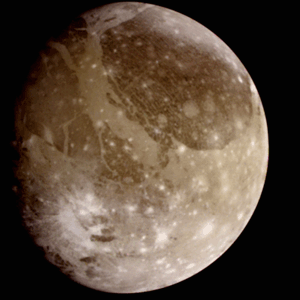Photographs taken by the Voyager missions in the 1970s revealed that the surface of Ganymede, Jupiter's largest moon, is heavily cratered and ridged suggesting it was shaped by tectonic forces. But astronomers had little idea of the origin of these processes and, in particular, why the rough terrain of the gigantic moon was criss-crossed with surprisingly smooth tracts. Now Paul Schenk of the Lunar and Planetary Institute in Houston, US, and colleagues believe that the flat regions may once have been deep trenches that were filled with an ice 'lava' (P M Schenk et al 2001 Nature 410 57).

Schenk’s team blended images collected by the Voyager expedition and the recent Galileo probe to construct a three-dimensional map of a region known as Sippar Sulcus, which covers thousands of square kilometres. The technique combines two-dimensional photographs taken from different angles to create a ‘digital elevation map’. The map revealed that the smooth areas lie at an altitude around 800 metres below that of the rugged regions. The depths of the grooves in the rough terrain contrast starkly with the flatness of the low-lying areas, and this strongly suggests that these areas are not original features but have been ‘resurfaced’ – or flooded. “These features directly support the idea that the smooth strips were created by volcanic activity”, says William B McKinnon, a member of the team. Moreover, the gentle gradient in the smooth areas implies that they were filled with a runny liquid, such as a mixture of ice and water. “The liquid is not like solid glacial ice, which would have rounded edges,” says McKinnon.
Schenk and co-workers speculate that Jupiter’s enormous tidal forces may have partially melted Ganymede’s frozen mantle to form the icy lava, which then weakened the surface and erupted through it, but they cannot be sure. It is also possible that liquid water existed on Ganymede – which is the largest moon in the solar system and bigger than Mercury – billions of years ago.



